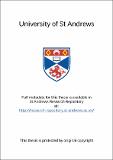Files in this item
The identification and characterisation of excreted proteins during early chick development
Item metadata
| dc.contributor.author | Connolly, Caroline | en |
| dc.coverage.spatial | 259p, 8p of plates. | en |
| dc.date.accessioned | 2021-04-08T08:59:33Z | |
| dc.date.available | 2021-04-08T08:59:33Z | |
| dc.date.issued | 1993 | |
| dc.identifier.uri | https://hdl.handle.net/10023/21946 | |
| dc.description.abstract | Proteins are transferred to medium conditioned by chick embryonic tissue. These secreted proteins are a diverse group of molecules including growth factors, proteases and glycoproteins. The majority of the secreted proteins present in conditioned medium are less than 70 kDa in molecular weight. Stage 17 to 22 embryos were used. TGF—β is present in this medium as a 25 kDa active protein and is formed from the breakdown of an inactive molecular weight form. To obtain an adequate quantity of conditioned medium to carry out protein assays a proportion of 1 head : 6 wing buds : 6 leg buds : 3 tail buds were used. A spatial distribution of this growth factor was thought to exist in the conditioned medium of head, wing buds, leg buds and tail buds and was present at a ratio of 5 : 1.4 : 1.6 :1, respectively. This suggested that TGF- β is present in regions of increased developmental activity. When the amount of secreted protein was compared to the amount of total protein in secreting tissue the ratio of TGF- β in the head, wing, leg and tail buds was 1 : 1.3 : 1.9 : 1.8, respectively. This suggested that no significant distribution of the growth factor existed in these regions and that head conditioned medium contained more TGF- β because there was more tissue present in the head than the limbs and tail. During the investigation, loss of activity was observed for many of the proteins of conditioned medium. This led to the discovery of a single proteolytic activity in conditioned medium. From 2 to 8 days of development this activity was present in the head, wing buds, leg buds and tail of the embryo, at a constant level. Other stages were not tested. It is active at physiological temperature and a pH of 7.5. It does not fit into any of the four known classes of proteases and is not one of the known proteases associated with development. It is therefore suggested that it is of a novel class. Since the protease is present in the media conditioned by chick tissue at a constant level from days 2 to 8 of development and TGF- β is also present but in increasing amounts, a role the protease may have on TGF- β processing was investigated. The protease does not activate latent TGF- β or inactivate active TGF- β. During an investigation into the effect TGF- β had on the proteolytic activity of the protease, to determine if TGF— β affected the proteolytic activity of the protease, it was discovered that TGF- β displayed proteolytic activity. The proteolytic properties of other growth factors were investigated to determine if proteolytic activity is a general property of growth factors. An effect was observed when the growth factors EGF or FGF and the protease were incubated together but since the growth factors also displayed proteolytic activity, it was impossible to say which protein affected which. Finally conditioned medium evokes a primary anchorage independent growth response in the presence of NRK 49F cells. This activity has been demonstrated to be due to a low molecular weight (less than 30 kDa), charged glycoprotein. Purification of a single molecule which produced this activity proved not to be possible and it is suggested that this activity requires the action of more than one glycoprotein. The glycoprotein mixture which displayed this primary response also possessed proteolytic activity. It is suggested that many of the proteins of conditioned medium possess more than one type of activity as a means of increasing efficiency. | en |
| dc.language.iso | en | en |
| dc.publisher | University of St Andrews | en |
| dc.subject.lcc | QP552.C7 | |
| dc.subject.lcsh | Transforming growth factors-beta | en |
| dc.subject.lcsh | Chickens--Embryos | en |
| dc.title | The identification and characterisation of excreted proteins during early chick development | en |
| dc.type | Thesis | en |
| dc.type.qualificationlevel | Doctoral | en |
| dc.type.qualificationname | PhD Doctor of Philosopy | en |
| dc.publisher.institution | The University of St Andrews | en |
This item appears in the following Collection(s)
Items in the St Andrews Research Repository are protected by copyright, with all rights reserved, unless otherwise indicated.

